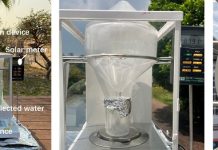
Researchers at the University of Virginia School of Engineering and Applied Science have made a significant breakthrough with a material known as MOF-525, a metal-organic framework (MOF) capable of capturing and converting carbon dioxide (CO2).
Assistant professor Gaurav “Gino” Giri’s team has discovered a way to produce this material on a large scale, making it practical for widespread use.
This innovation could play a crucial role in tackling climate change and meeting global energy needs.
MOF-525 belongs to a class of materials called metal-organic frameworks, which are known for their ultra-porous, crystalline structures.
These structures create vast internal surface areas that can trap various chemical compounds, functioning like sponges.
If MOFs can cover large areas, they could be used to create membranes for carbon capture and electrocatalytic conversion in one system.
Electrocatalytic conversion is a process that uses renewable energy to create chemicals, eliminating the need for fossil fuels.
This makes the new method environmentally friendly and efficient. Giri’s team focused on a scalable technique called solution shearing to fabricate the MOFs.
In this process, the components of the MOF are mixed in a solution and spread across a substrate using a shearing blade. As the solution evaporates, chemical bonds form the MOF as a thin film on the substrate.
“The bigger the membrane, the more surface area you have for the reaction, and the more product you could get,” said Prince Verma, a recent Ph.D. graduate from Giri’s lab.
“With this process, you can increase the shearing blade width to whatever size you need.”
The team demonstrated their approach by targeting CO2 conversion.
Carbon capture is widely used to reduce industrial emissions or remove CO2 from the atmosphere, but it often comes at a high cost with little return. CO2 is usually stored underground without any commercial value.
However, using minimal energy input, MOF-525 can convert CO2 into carbon monoxide (CO), a valuable chemical used in manufacturing fuels, pharmaceuticals, and other products.
The researchers published their findings in the American Chemical Society journal Applied Materials and Interfaces.
The team included Connor A. Koellner, Hailey Hall, Meagan R. Phister, Kevin H. Stone, Asa W. Nichols, Ankit Dhakal, and Earl Ashcraft.
This discovery provides a new, scalable way to use MOF-525 for carbon capture and conversion, offering a promising solution to reduce greenhouse gas emissions and produce valuable chemicals from captured CO2.



